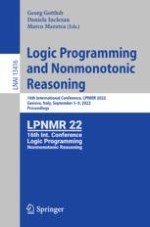1 Introduction
2 Preliminaries
 ). Then I satisfies a rule \(r\,\in \, P\) of forms (1) and (3), denoted \(I\models r\), if the satisfaction of the body, denoted \(I\models \textrm{body}(r)\), implies that \(\textrm{head}(r)\,\in \, I\), i.e., \(I\models \textrm{head}(r)\). For a choice rule r of form (2), \(I\models r\) unconditionally. Moreover, the interpretation I is a (classical) model of P if \(I\models r\) holds for every \(r\,\in \, P\). Each positive program P has a unique least model \(\textrm{LM}(P)\) obtained as the intersection \(\bigcap \{{I\subseteq \textrm{At}(P)}\mid {I\models P}\}\).
). Then I satisfies a rule \(r\,\in \, P\) of forms (1) and (3), denoted \(I\models r\), if the satisfaction of the body, denoted \(I\models \textrm{body}(r)\), implies that \(\textrm{head}(r)\,\in \, I\), i.e., \(I\models \textrm{head}(r)\). For a choice rule r of form (2), \(I\models r\) unconditionally. Moreover, the interpretation I is a (classical) model of P if \(I\models r\) holds for every \(r\,\in \, P\). Each positive program P has a unique least model \(\textrm{LM}(P)\) obtained as the intersection \(\bigcap \{{I\subseteq \textrm{At}(P)}\mid {I\models P}\}\). . Finally, for an entire WCP P, the reduct \({P}^{I}=\bigcup \{{{r}^{I}}\mid {r\,\in \, P}\}\) and I is a stable model of P iff \(I=\textrm{LM}({P}^{I})\). For the purposes of this work, it is also useful to distinguish the supporting rules of P with respect to I, i.e., \(\textrm{SR}_{P}(I)=\{{r\,\in \, P}\mid {\textrm{head}(r)\,\in \, I, I\models \textrm{body}(r)}\}\). Then, a model \(I\models P\) is supported (by P) when \(I=\{{\textrm{head}(r)}\mid {r\,\in \,\textrm{SR}_{P}(I)}\}\). Each stable model of P is supported by P, but supported models are not necessarily stable, such as \(I=\{a\}\) for \(P=\{a\leftarrow a.\}\).
. Finally, for an entire WCP P, the reduct \({P}^{I}=\bigcup \{{{r}^{I}}\mid {r\,\in \, P}\}\) and I is a stable model of P iff \(I=\textrm{LM}({P}^{I})\). For the purposes of this work, it is also useful to distinguish the supporting rules of P with respect to I, i.e., \(\textrm{SR}_{P}(I)=\{{r\,\in \, P}\mid {\textrm{head}(r)\,\in \, I, I\models \textrm{body}(r)}\}\). Then, a model \(I\models P\) is supported (by P) when \(I=\{{\textrm{head}(r)}\mid {r\,\in \,\textrm{SR}_{P}(I)}\}\). Each stable model of P is supported by P, but supported models are not necessarily stable, such as \(I=\{a\}\) for \(P=\{a\leftarrow a.\}\).3 Translating ASP into SAT Modulo Graphs/Acyclicity
3.1 Normalization
3.2 Instrumentation with Acyclicity Constraint
 . Then, if a defining rule \(r\,\in \,\textrm{def}_{P}(a)\) is of the form (1) or (2), the rule (4) below captures well-support mediated by r, but if it is of the form (3), then the rule is (5).
. Then, if a defining rule \(r\,\in \,\textrm{def}_{P}(a)\) is of the form (1) or (2), the rule (4) below captures well-support mediated by r, but if it is of the form (3), then the rule is (5).3.3 Program Completion Modulo Acyclicity
4 Vertex Elimination
5 Translating SAT Modulo Acyclicity into Pure SAT
6 Translating ASP into Pure SAT
7 Experimental Evaluation
Problem Set | Problems | Solved | ||||
|---|---|---|---|---|---|---|
SAT | CLASP | WASP | GRAPHSAT | BIN | ||
CombinedConfiguration | 99 | 66 | 65 | 19 | 26 | 33 |
Hamiltonian | 300 | 282 | 199 | 276 | 300 | 194 |
KnightTourWithHoles | 300 | 44 | 40 | 37 | 31 | 26 |
Labyrinth | 246 | 205 | 209 | 191 | 109 | 156 |
MazeGeneration | 50 | 50 | 50 | 50 | 50 | 22 |
RandomNonTight | 14 | 14 | 14 | 12 | 14 | 14 |
Total | 1219 | 661 | 577 | 585 | 530 | 445 |
